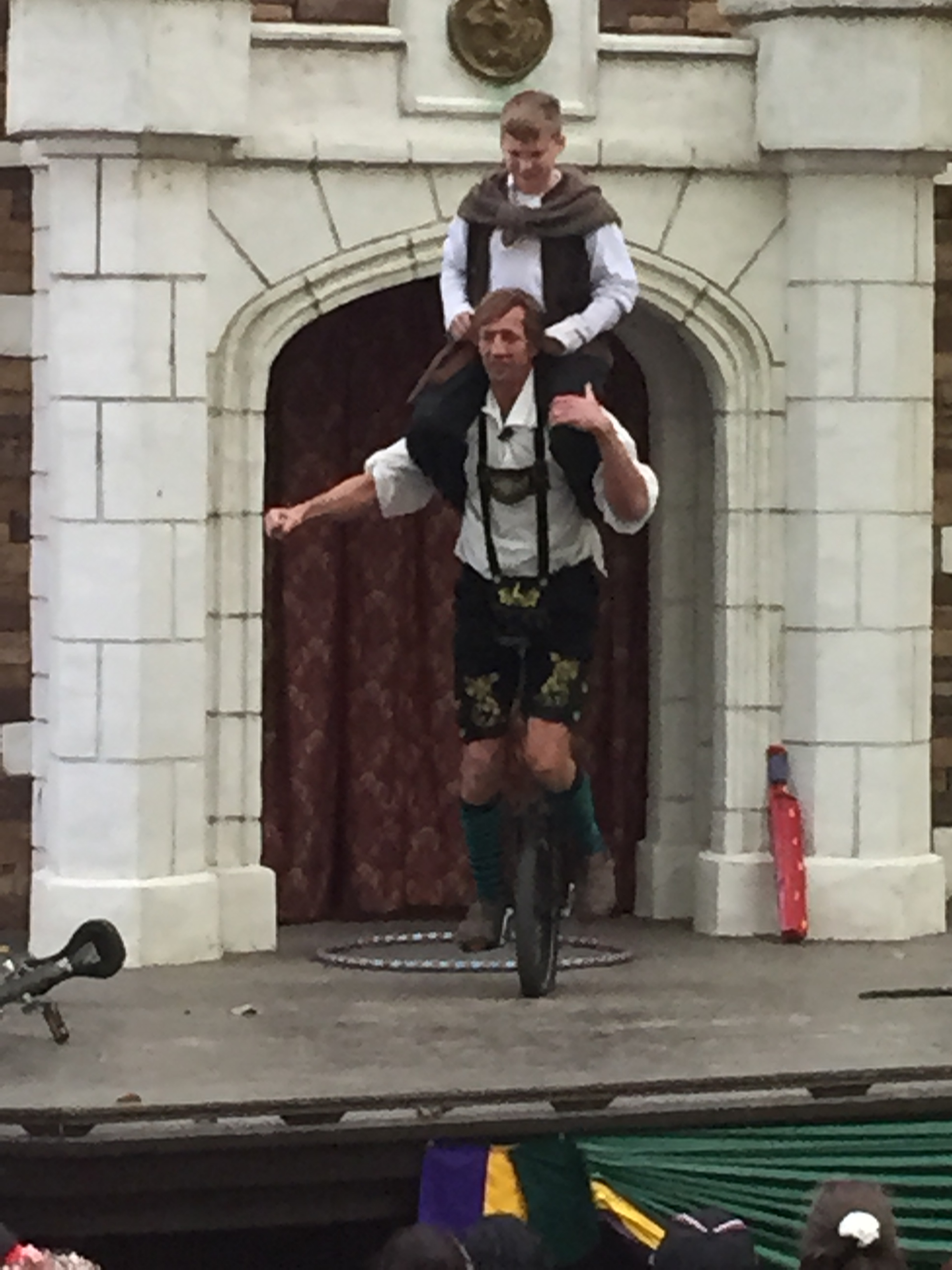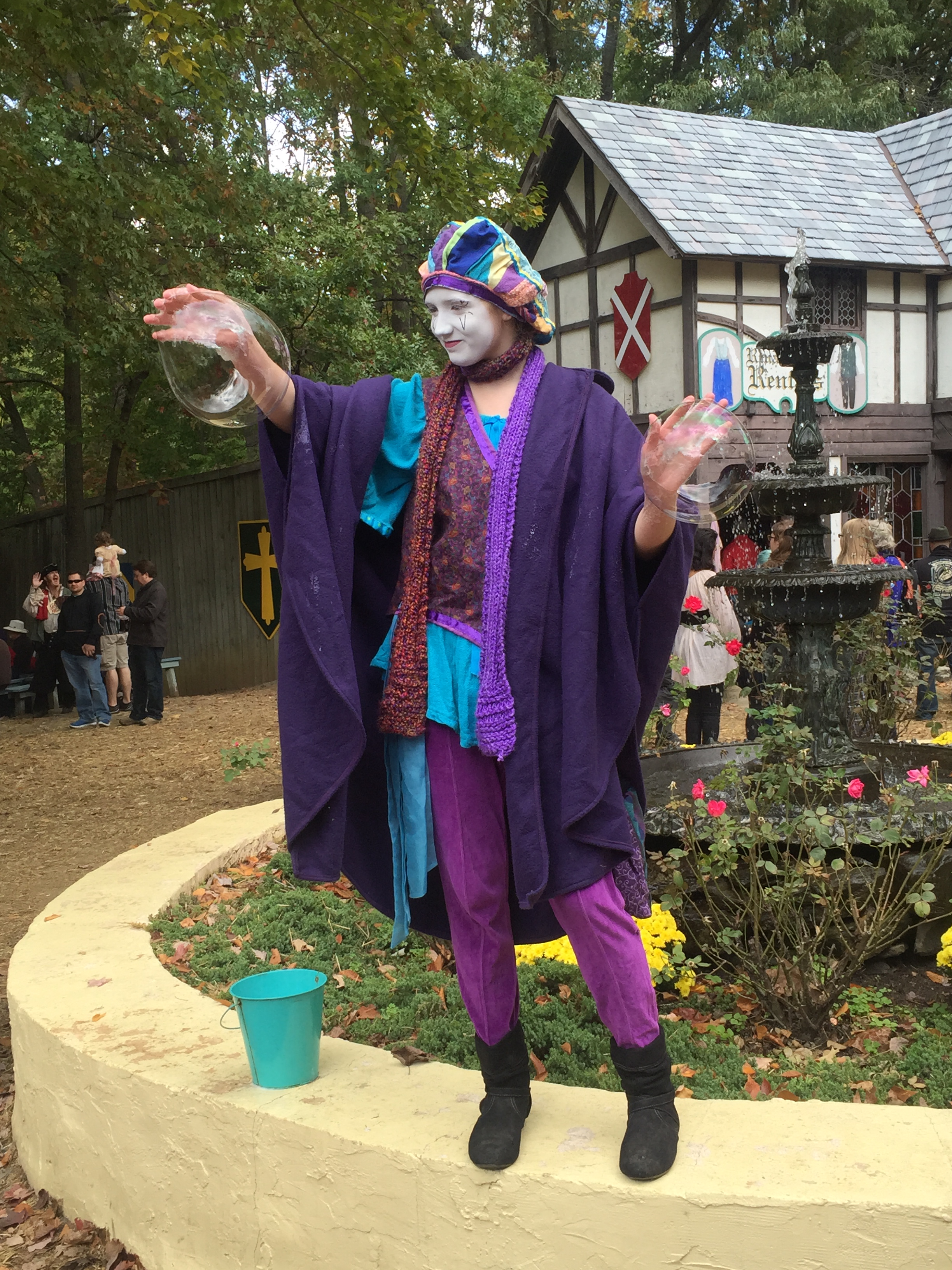
I’m not a huge fan of the Disney princesses, but I have always been a knights and castles kind of girl. The sieges, battles and court fascinated me since I was in elementary school. So combined with my love of dressing up, it’s a natural fit for me to love Renaissance faires, which offer the most fantastical and romanticized version of that era possible. Thankfully, they’re very family friendly, even for the youngest of kids. After we had a great time last year, we brought Sprout back to the Maryland Renaissance Festival again last weekend. With these experiences, here are a few things I’ve learned about attending these events with young children:
1) Know that they involve lot of walking, but aren’t stroller-friendly.
Renaissance faires are typically held in huge fields, with more than 100 exhibitors and stands. As they mimic a village, the buildings take up more room than you would expect – they’re not crammed in like booths at a craft fair. They’re often planned like a medieval village with odd little side streets, so seeing everything requires walking in circles. In addition, they can serve thousands of people a day, so the parking lot is very large. As a result, you may walk more than a mile or even two over the course of the day. However, I wouldn’t recommend bringing a stroller, if possible. The paths are usually unpaved and our faire has a number of very steep hills. They can also be very crowded. If your little one can’t walk that far, a baby backpack is the best bet. If you do bring a stroller, it needs to be a heavy-duty one; an umbrella stroller will be useless on the terrain.
2) Figure out what shows you want to see on the drive there.
With more than 50 separate shows to choose from at 12 locations, there’s a lot to do at our faire. From mini-plays to knighting kids, it can be overwhelming, not to mention wandering bards on the paths. As a result, it’s easy to lose track of time and completely miss the show you really want to see. We decided that the one show we really wanted to see was the jousting; everything else was a bonus. On the way there, we stopped for a juggler with an absurd German accent that Sprout found surprisingly entertaining.
3) Buy tickets online, if you can.
The lines can be long and our faire offers tickets for the same price online as at the Gate. The faster you can get everyone inside, the better.
4) Feel free to dress up – or not.
Like Comic-Con, one of the most fun things to do at the Renaissance faire is costume spotting. Staff and attendees alike are often elaborately dressed, ranging from historically accurate to just ornately pretty. If you want to get in on it, you can make your own or in some cases, even rent them there. But also don’t feel obliged to dress up. I’ve gone in costume previously but went in jeans this year because I really didn’t want to deal with multiple layers of skirts at port-a-potties.
5) Dress to adapt for changing weather.
Whether you wear a costume or not, be prepared for the weather. Faires tend to be almost completely outside with hardly anywhere that provides protection from the elements. Last year at the beginning of September, the sun beat down and I was sweaty in my sleeveless but lined dress. This year in October, the highs in the mid-50s made us feel a bit chilled despite our layered sweaters and jackets. We didn’t bring rain gear, but it would have been a good idea.
6) Bring a water bottle.
As many faires are in the summer and early fall, it can be staggeringly hot. Combined with the amount of walking, both parents and kids can easily get dehydrated. The food can be expensive with long lines, so it’s best to fill up your own bottle at water stations there.
7) Set a shopping budget.
One of my favorite things about the Renaissance Faire is that it’s an artist and crafter showcase in disguise. Small artisans, including leather workers, weavers, glassblowers, jewelry makers, toy makers, and costume designers sell their wares, all with a medieval flair. But they also charge prices appropriate to their time and effort, which can be much higher than retail. It’s easy to either spend far more than you intended or decide the prices are too high and regret it later. (Some of the vendors have websites, but their inventory is generally much worse than in person.) Often, the faire will list vendors on its website, so if you can look over it ahead of time, you can set a list of things you might want to buy (ex. a handmade toy sword) and how much you want to spend.
6) Be willing to spend a little on extras.
Along with the shows and vendors, the Maryland Festival has a variety of “amusements,” including a maze, Jacob’s ladder, ax throwing, archery, tests of strength, giant slides, and puzzle games. Unlike the County Fair carnival, which has the sole purpose of separating you from your money, the atmosphere is more laid back. The games also tend to be much cheaper and more unique. I spent a dollar to play a giant wooden pinball machine and the amusement value for both Sprout and I justified the price.
7) Take some time for free play.
Being overly scheduled or dragged from booth to booth can be boring for kids, so it’s good to let them run around. Our faire has a playground built around a giant wooden pirate ship. Having watched some of the other kids on it, I do ask that you take away their new toy swords before you let them loose on the playground.
8) Try to teach your toddler to say the word “Renaissance.”
We weren’t trying to teach Sprout, but he just picked it up from conversation and it’s really adorable.

